publications
peer-reviewed publications by categories in reversed chronological order. generated by jekyll-scholar.
2023
-
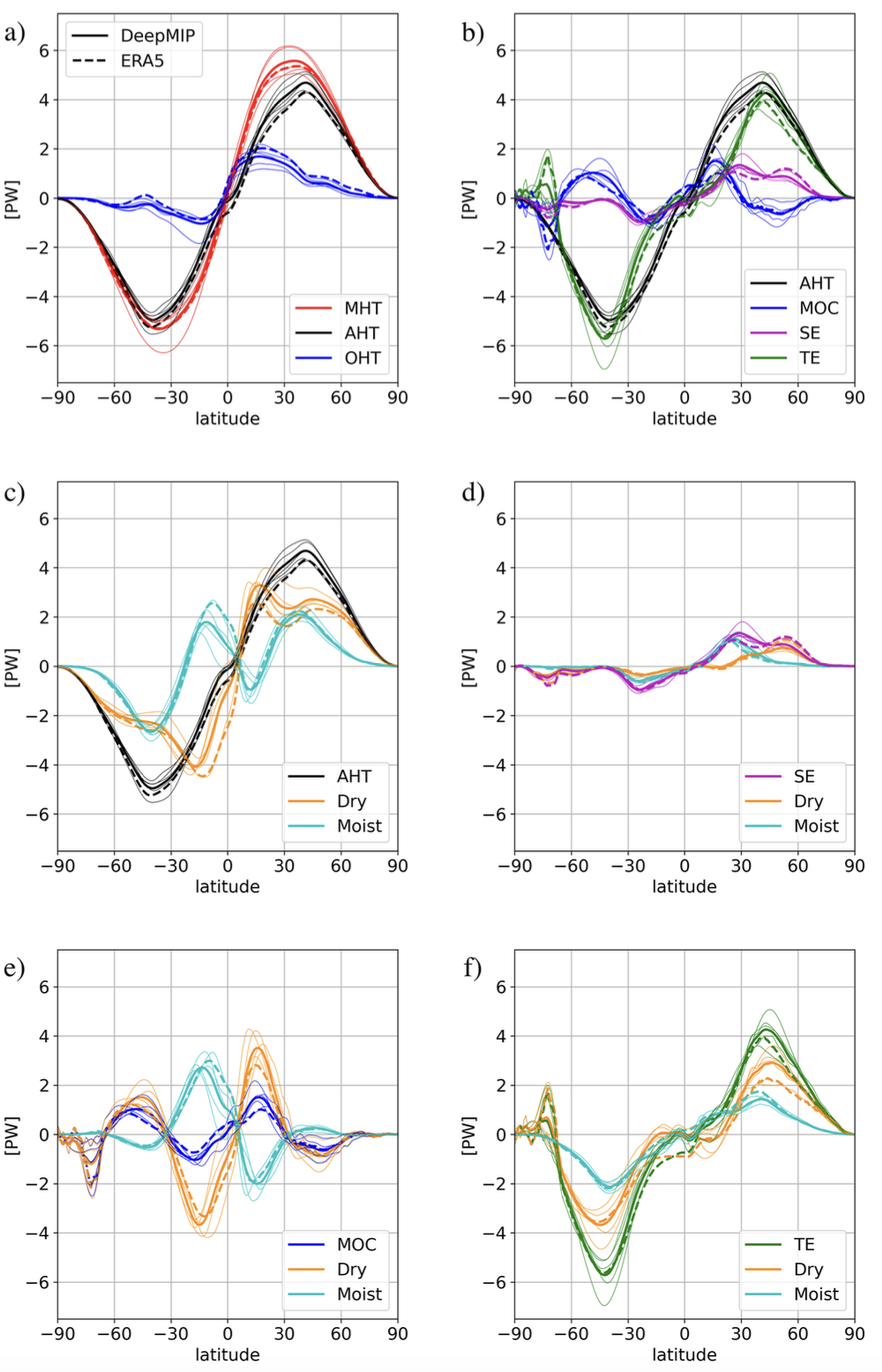 Meridional Heat Transport in the DeepMIP Eocene Ensemble: Non-CO2 and CO2 EffectsFanni Dora Kelemen, Sebastian Steinig, Agatha De Boer, Jiang Zhu, Wing‐Le Chan, Igor Niezgodzki, David K. Hutchinson, Gregor Knorr, Ayako Abe‐Ouchi, and Bodo AhrensPaleoceanography and Paleoclimatology, Aug 2023
Meridional Heat Transport in the DeepMIP Eocene Ensemble: Non-CO2 and CO2 EffectsFanni Dora Kelemen, Sebastian Steinig, Agatha De Boer, Jiang Zhu, Wing‐Le Chan, Igor Niezgodzki, David K. Hutchinson, Gregor Knorr, Ayako Abe‐Ouchi, and Bodo AhrensPaleoceanography and Paleoclimatology, Aug 2023The total meridional heat transport (MHT) is relatively stable across different climates. Nevertheless, the strength of individual processes contributing to the total transport are not stable. Here we investigate the MHT and its main components especially in the atmosphere, in five coupled climate model simulations from the Deep-Time Model Intercomparison Project (DeepMIP). These simulations target the early Eocene climatic optimum, a geological time period with high CO2 concentrations, analog to the upper range of end-of-century CO2 projections. Preindustrial and early Eocene simulations, at a range of CO2 levels are used to quantify the MHT changes in response to both CO2 and non-CO2 related forcings. We found that atmospheric poleward heat transport increases with CO2, while oceanic poleward heat transport decreases. The non-CO2 boundary conditions cause more MHT toward the South Pole, mainly through an increase in the southward oceanic heat transport. The changes in paleogeography increase the heat transport via transient eddies at the northern mid-latitudes in the Eocene. The Eocene Hadley cells do not transport more heat poleward, but due to the warmer atmosphere, especially the northern cell, circulate more heat in the tropics, than today. The monsoon systems’ poleward latent heat transport increases with rising CO2 concentrations, but this change is counterweighted by the globally smaller Eocene monsoon area. Our results show that the changes in the monsoon systems’ latent heat transport is a robust feature of CO2 warming, which is in line with the currently observed precipitation increase of present day monsoon systems.
-
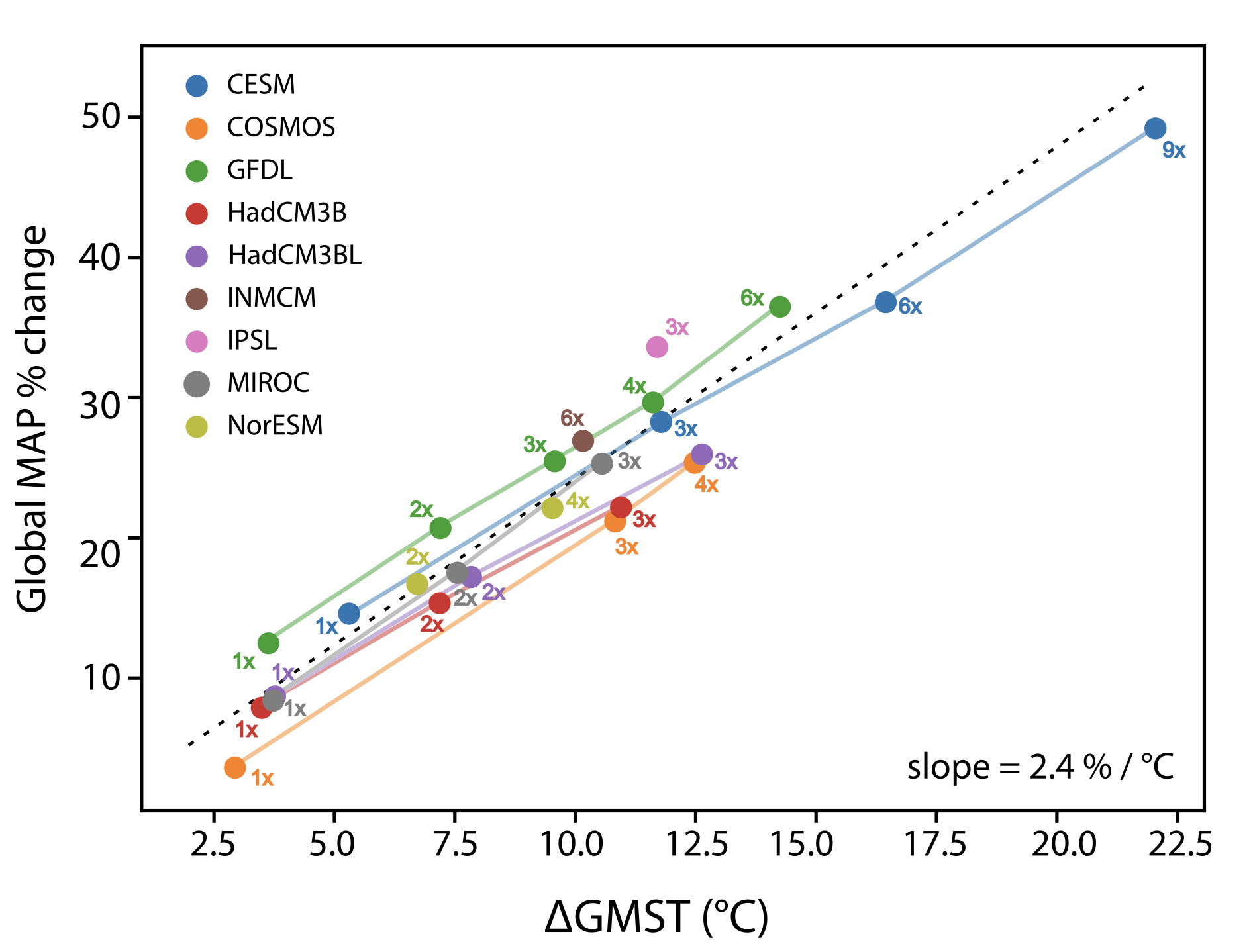 Global and Zonal‐Mean Hydrological Response to Early Eocene WarmthMargot J. Cramwinckel, Natalie J. Burls, Abdullah A. Fahad, Scott Knapp, Christopher K. West, Tammo Reichgelt, David R. Greenwood, Wing‐Le Chan, Yannick Donnadieu, David K. Hutchinson, Agatha M. De Boer, Jean‐Baptiste Ladant, Polina A. Morozova, Igor Niezgodzki, Gregor Knorr, Sebastian Steinig, Zhongshi Zhang, Jiang Zhu, Ran Feng, Daniel J. Lunt, Ayako Abe‐Ouchi, and Gordon N. InglisPaleoceanography and Paleoclimatology, Jun 2023
Global and Zonal‐Mean Hydrological Response to Early Eocene WarmthMargot J. Cramwinckel, Natalie J. Burls, Abdullah A. Fahad, Scott Knapp, Christopher K. West, Tammo Reichgelt, David R. Greenwood, Wing‐Le Chan, Yannick Donnadieu, David K. Hutchinson, Agatha M. De Boer, Jean‐Baptiste Ladant, Polina A. Morozova, Igor Niezgodzki, Gregor Knorr, Sebastian Steinig, Zhongshi Zhang, Jiang Zhu, Ran Feng, Daniel J. Lunt, Ayako Abe‐Ouchi, and Gordon N. InglisPaleoceanography and Paleoclimatology, Jun 2023Earth’s hydrological cycle is expected to intensify in response to global warming, with a “wet-gets-wetter, dry-gets-drier” response anticipated over the ocean. Subtropical regions (∼15°–30°N/S) are predicted to become drier, yet proxy evidence from past warm climates suggests these regions may be characterized by wetter conditions. Here we use an integrated data-modeling approach to reconstruct global and zonal-mean rainfall patterns during the early Eocene (∼56–48 million years ago). The Deep-Time Model Intercomparison Project (DeepMIP) model ensemble indicates that the mid- (30°–60°N/S) and high-latitudes (\textgreater60°N/S) are characterized by a thermodynamically dominated hydrological response to warming and overall wetter conditions. The tropical band (0°–15°N/S) is also characterized by wetter conditions, with several DeepMIP models simulating narrowing of the Inter-Tropical Convergence Zone. However, the latter is not evident from the proxy data. The subtropics are characterized by negative precipitation-evaporation anomalies (i.e., drier conditions) in the DeepMIP models, but there is surprisingly large inter-model variability in mean annual precipitation (MAP). Intriguingly, we find that models with weaker meridional temperature gradients (e.g., CESM, GFDL) are characterized by a reduction in subtropical moisture divergence, leading to an increase in MAP. These model simulations agree more closely with our new proxy-derived precipitation reconstructions and other key climate metrics and imply that the early Eocene was characterized by reduced subtropical moisture divergence. If the meridional temperature gradient was even weaker than suggested by those DeepMIP models, circulation-induced changes may have outcompeted thermodynamic changes, leading to wetter subtropics. This highlights the importance of accurately reconstructing zonal temperature gradients when reconstructing past rainfall patterns.
-
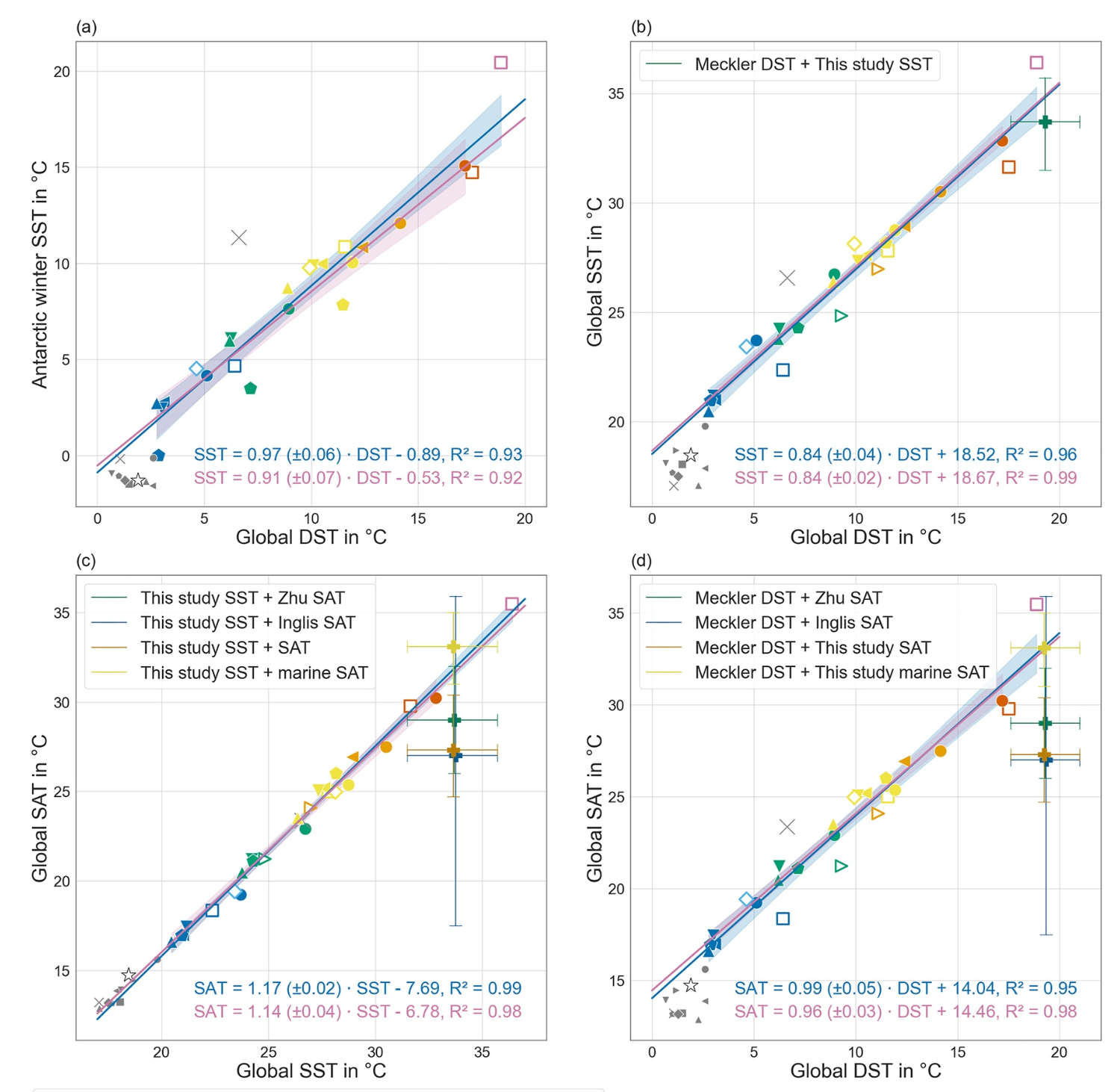 The Relationship Between the Global Mean Deep‐Sea and Surface Temperature During the Early EoceneBarbara Goudsmit‐Harzevoort, Angelique Lansu, Michiel L. J. Baatsen, Anna S. Von Der Heydt, Niels J. De Winter, Yurui Zhang, Ayako Abe‐Ouchi, Agatha De Boer, Wing‐Le Chan, Yannick Donnadieu, David K. Hutchinson, Gregor Knorr, Jean‐Baptiste Ladant, Polina Morozova, Igor Niezgodzki, Sebastian Steinig, Aradhna Tripati, Zhongshi Zhang, Jiang Zhu, and Martin ZieglerPaleoceanography and Paleoclimatology, Mar 2023
The Relationship Between the Global Mean Deep‐Sea and Surface Temperature During the Early EoceneBarbara Goudsmit‐Harzevoort, Angelique Lansu, Michiel L. J. Baatsen, Anna S. Von Der Heydt, Niels J. De Winter, Yurui Zhang, Ayako Abe‐Ouchi, Agatha De Boer, Wing‐Le Chan, Yannick Donnadieu, David K. Hutchinson, Gregor Knorr, Jean‐Baptiste Ladant, Polina Morozova, Igor Niezgodzki, Sebastian Steinig, Aradhna Tripati, Zhongshi Zhang, Jiang Zhu, and Martin ZieglerPaleoceanography and Paleoclimatology, Mar 2023Estimates of global mean near-surface air temperature (global SAT) for the Cenozoic era rely largely on paleo-proxy data of deep-sea temperature (DST), with the assumption that changes in global SAT covary with changes in the global mean deep-sea temperature (global DST) and global mean sea-surface temperature (global SST). We tested the validity of this assumption by analyzing the relationship between global SST, SAT, and DST using 25 different model simulations from the Deep-Time Model Intercomparison Project simulating the early Eocene Climatic Optimum (EECO) with varying CO2 levels. Similar to the modern situation, we find limited spatial variability in DST, indicating that local DST estimates can be regarded as a first order representative of global DST. In line with previously assumed relationships, linear regression analysis indicates that both global DST and SAT respond stronger to changes in atmospheric CO2 than global SST by a similar factor. Consequently, this model-based analysis validates the assumption that changes in global DST can be used to estimate changes in global SAT during the early Cenozoic. Paleo-proxy estimates of global DST, SST, and SAT during EECO show the best fit with model simulations with a 1,680 ppm atmospheric CO2 level. This matches paleo-proxies of EECO atmospheric CO2, indicating a good fit between models and proxy-data.
2022
-
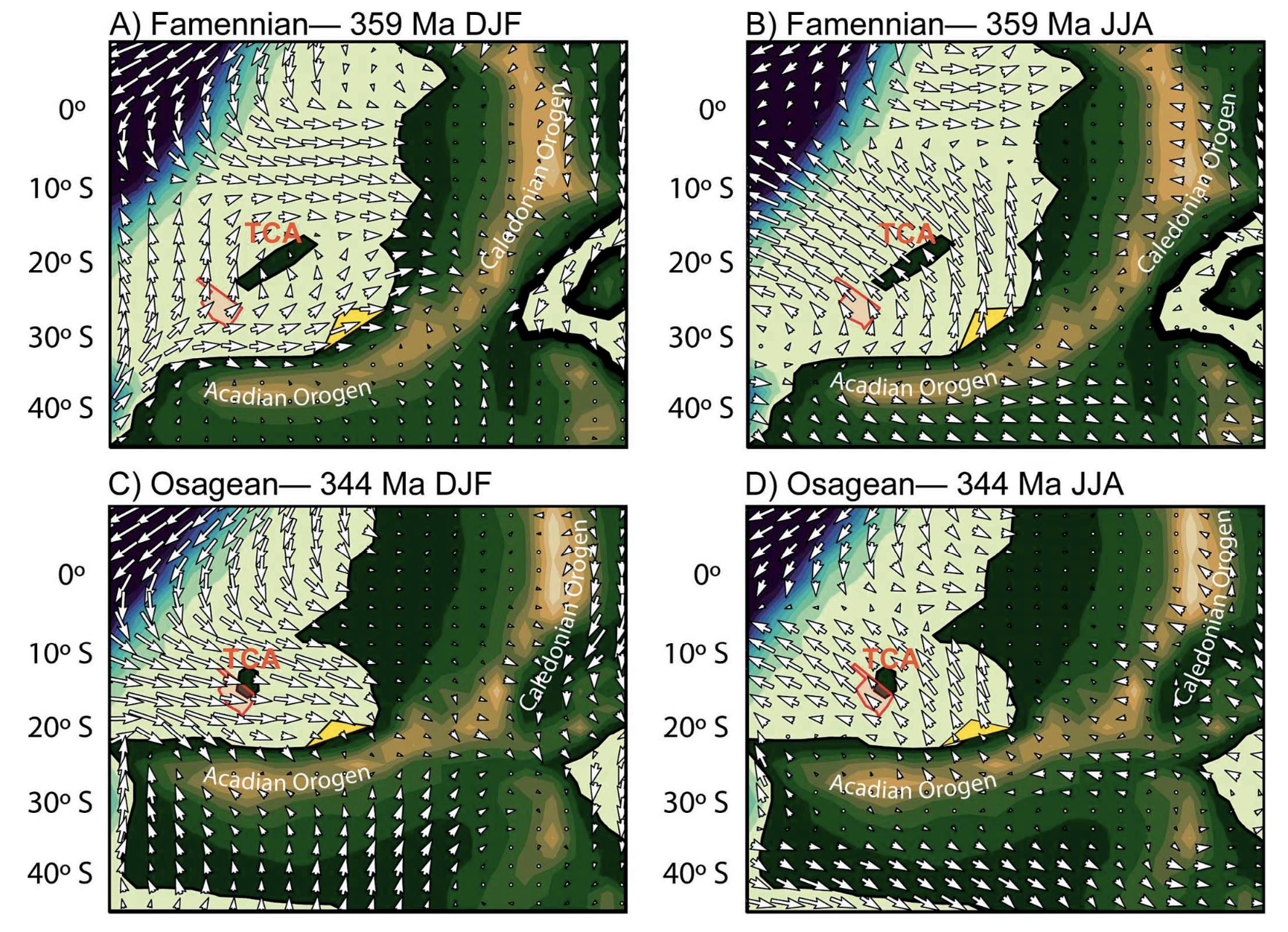 An eolian dust origin for clastic fines of Devono-Mississippian mudrocks of the greater North American midcontinentAustin J. McGlannan, Alicia Bonar, Lily Pfeifer, Sebastian Steinig, Paul Valdes, Steven Adams, David Duarte, Benmadi Milad, Andrew Cullen, and Gerilyn S. SoreghanJournal of Sedimentary Research, Dec 2022
An eolian dust origin for clastic fines of Devono-Mississippian mudrocks of the greater North American midcontinentAustin J. McGlannan, Alicia Bonar, Lily Pfeifer, Sebastian Steinig, Paul Valdes, Steven Adams, David Duarte, Benmadi Milad, Andrew Cullen, and Gerilyn S. SoreghanJournal of Sedimentary Research, Dec 2022Upper Devonian and Lower–Middle Mississippian strata of the North American midcontinent are ubiquitously fine-grained and silt-rich, comprising both so-called shale as well as argillaceous limestone (or calcareous siltstone) that accumulated in the Laurentian epeiric sea. Although long recognized as recording marine deposition, the origin and transport of the fine-grained siliciclastic material in these units remains enigmatic because they do not connect to any proximal deltaic feeder systems. Here, we present new data on grain size, whole-rock geochemistry, mineralogy, and U-Pb detrital-zircon geochronology from units across Oklahoma; we then integrate these data with models of surface wind circulation, refined paleogeographic reconstructions, and correlations from the greater midcontinent to test the hypothesis that wind transported the siliciclastic fraction to the marine system. The exclusively very fine silt to very fine sand grain size, clear detrital origin, widespread distribution over large regions of the epeiric sea, Appalachian sources, and paleogeographic setting in the subtropical arid belt far-removed from contemporaneous deltaic feeder systems are most consistent with eolian transport of dust lofted from subaerial delta plains of the greater Appalachian orogen and incorporated into subaqueous depositional systems. Delivery of dust that was minimally chemically weathered to Devono-Mississippian epeiric seas likely provided essential nutrients that stimulated organic productivity in these commonly organic-rich units.
-
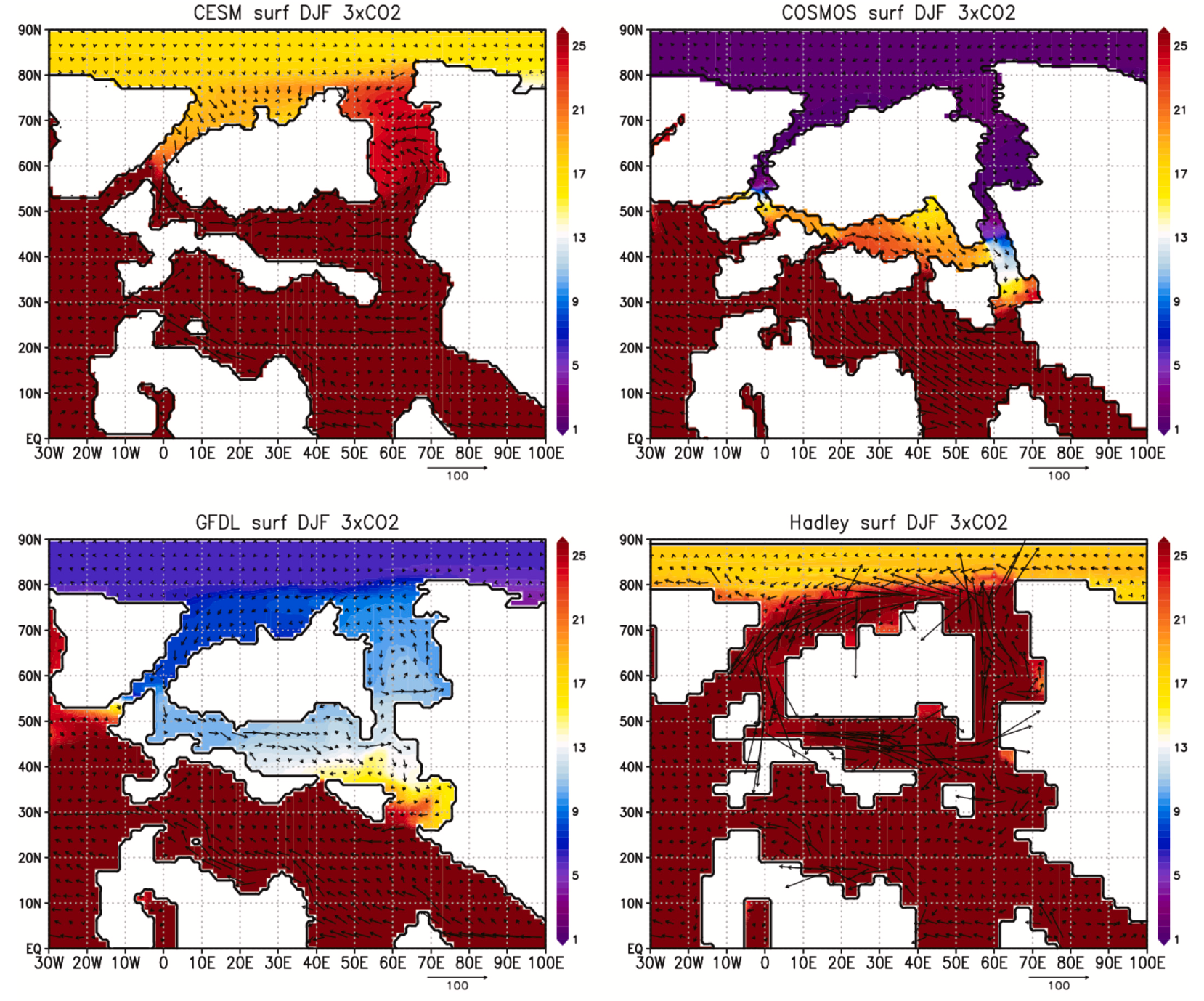 Simulation of Arctic sea ice within the DeepMIP Eocene ensemble: Thresholds, seasonality and factors controlling sea ice developmentIgor Niezgodzki, Gregor Knorr, Gerrit Lohmann, Daniel J. Lunt, Christopher J. Poulsen, Sebastian Steinig, Jiang Zhu, Agatha De Boer, Wing-Le Chan, Yannick Donnadieu, David K. Hutchinson, Jean-Baptiste Ladant, and Polina MorozovaGlobal and Planetary Change, Jul 2022
Simulation of Arctic sea ice within the DeepMIP Eocene ensemble: Thresholds, seasonality and factors controlling sea ice developmentIgor Niezgodzki, Gregor Knorr, Gerrit Lohmann, Daniel J. Lunt, Christopher J. Poulsen, Sebastian Steinig, Jiang Zhu, Agatha De Boer, Wing-Le Chan, Yannick Donnadieu, David K. Hutchinson, Jean-Baptiste Ladant, and Polina MorozovaGlobal and Planetary Change, Jul 2022The early Eocene greenhouse climate maintained by high atmospheric CO2 concentrations serves as a testbed for future climate changes dominated by increasing CO2 forcing. In particular, the early Eocene Arctic region is important in the context of future CO2 driven climate warming in the northern polar region and associated shrinking Arctic sea ice. Here, we present early Eocene Arctic sea ice simulations carried out by six coupled climate models within the framework of the Deep-Time Model Intercomparison Project (DeepMIP). We find differences in sea ice responses to CO2 changes across the ensemble and compare the results with available proxybased sea ice reconstructions from the Arctic Ocean. Most of the models simulate seasonal sea ice presence at high CO2 levels (≥ 840 ppmv = 3× pre-industrial (PI) level of 280 ppmv). However, the threshold when sea ice permanently disappears from the ocean varies considerably between the models (from \textless840 ppmv to \textgreater1680 ppmv). Based on a one-dimensional energy balance model analysis we find that the greenhouse effect likely caused by increased atmospheric water vapor concentration plays an important role in the inter-model spread in Arctic winter surface temperature changes in response to a CO2 rise from 1× to 3× the PI level. Furthermore, differences in simulated surface salinity in the Arctic Ocean play an important role in the control of local sea ice formation. These differences result from different implementations of river run-off between the models, but also from differences in the exchange of waters between a brackish Arctic and a more saline North Atlantic Ocean that are controlled by the width of the gateway between both basins. As there is no geological evidence for Arctic sea ice in the early Eocene, its presence in most of the simulations with 3× PI CO2 level indicates either a higher CO2 level and/or an overly weak polar sensitivity in these models.
-
 Plant Proxy Evidence for High Rainfall and Productivity in the Eocene of AustraliaTammo Reichgelt, David R. Greenwood, Sebastian Steinig, John G. Conran, David K. Hutchinson, Daniel J. Lunt, Leonie J. Scriven, and Jiang ZhuPaleoceanography and Paleoclimatology, Jun 2022
Plant Proxy Evidence for High Rainfall and Productivity in the Eocene of AustraliaTammo Reichgelt, David R. Greenwood, Sebastian Steinig, John G. Conran, David K. Hutchinson, Daniel J. Lunt, Leonie J. Scriven, and Jiang ZhuPaleoceanography and Paleoclimatology, Jun 2022During the early to middle Eocene, a mid-to-high latitudinal position and enhanced hydrological cycle in Australia would have contributed to a wetter and “greener” Australian continent where today arid to semi-arid climates dominate. Here, we revisit 12 southern Australian plant megafossil sites from the early to middle Eocene to generate temperature, precipitation, and seasonality paleoclimate estimates, net primary productivity (NPP), and vegetation type, based on paleobotanical proxies and compare them to early Eocene global climate models. Temperature reconstructions are uniformly subtropical (mean annual, summer, and winter mean temperatures 19–21°C, 25–27°C, and 14–16°C, respectively), indicating that southern Australia was ∼5°C warmer than today, despite a \textgreater20° poleward shift from its modern geographic location. Precipitation was less homogeneous than temperature, with mean annual precipitation of ∼60 cm over inland sites and \textgreater100 cm over coastal sites. Precipitation may have been seasonal with the driest month receiving 2–7× less than the mean monthly precipitation. Proxy-model comparison is favorable with a 1,680 ppm CO2 concentration. However, individual proxy reconstructions can disagree with models as well as with each other. In particular, seasonality reconstructions have systemic offsets. NPP estimates were higher than modern, implying a more homogenously “green” southern Australia in the early to middle Eocene when this part of Australia was at 48–64°S and larger carbon fluxes to and from the Australian biosphere. The most similar modern vegetation type is modern-day eastern Australian subtropical forest, although the distance from coast and latitude may have led to vegetation heterogeneity.
-
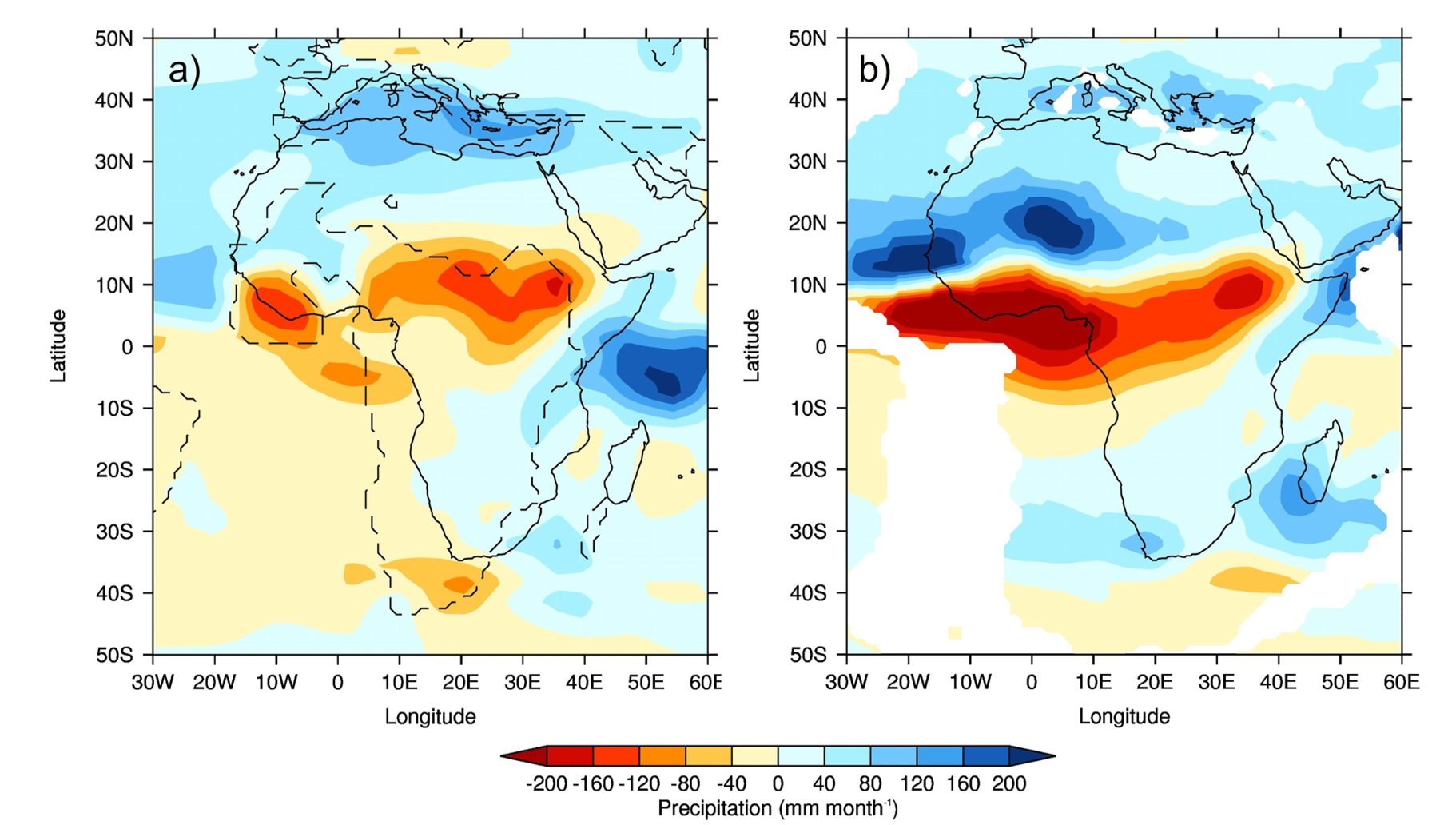 African Hydroclimate During the Early Eocene From the DeepMIP SimulationsCharles J. R. Williams, Daniel J. Lunt, Ulrich Salzmann, Tammo Reichgelt, Gordon N. Inglis, David R. Greenwood, Wing‐Le Chan, Ayako Abe‐Ouchi, Yannick Donnadieu, David K. Hutchinson, Agatha M. De Boer, Jean‐Baptiste Ladant, Polina A. Morozova, Igor Niezgodzki, Gregor Knorr, Sebastian Steinig, Zhongshi Zhang, Jiang Zhu, Matthew Huber, and Bette L. Otto‐BliesnerPaleoceanography and Paleoclimatology, May 2022
African Hydroclimate During the Early Eocene From the DeepMIP SimulationsCharles J. R. Williams, Daniel J. Lunt, Ulrich Salzmann, Tammo Reichgelt, Gordon N. Inglis, David R. Greenwood, Wing‐Le Chan, Ayako Abe‐Ouchi, Yannick Donnadieu, David K. Hutchinson, Agatha M. De Boer, Jean‐Baptiste Ladant, Polina A. Morozova, Igor Niezgodzki, Gregor Knorr, Sebastian Steinig, Zhongshi Zhang, Jiang Zhu, Matthew Huber, and Bette L. Otto‐BliesnerPaleoceanography and Paleoclimatology, May 2022The early Eocene (∼56–48 Myr ago) is characterized by high CO2 estimates (1,200–2,500 ppmv) and elevated global temperatures (∼10°C–16°C higher than modern). However, the response of the hydrological cycle during the early Eocene is poorly constrained, especially in regions with sparse data coverage (e.g., Africa). Here, we present a study of African hydroclimate during the early Eocene, as simulated by an ensemble of state-of-the-art climate models in the Deep-time Model Intercomparison Project (DeepMIP). A comparison between the DeepMIP pre-industrial simulations and modern observations suggests that model biases are model- and geographically dependent, however, these biases are reduced in the model ensemble mean. A comparison between the Eocene simulations and the pre-industrial suggests that there is no obvious wetting or drying trend as the CO2 increases. The results suggest that changes to the land sea mask (relative to modern) in the models may be responsible for the simulated increases in precipitation to the north of Eocene Africa. There is an increase in precipitation over equatorial and West Africa and associated drying over northern Africa as CO2 rises. There are also important dynamical changes, with evidence that anticyclonic low-level circulation is replaced by increased south-westerly flow at high CO2 levels. Lastly, a model-data comparison using newly compiled quantitative climate estimates from paleobotanical proxy data suggests a marginally better fit with the reconstructions at lower levels of CO2.
-
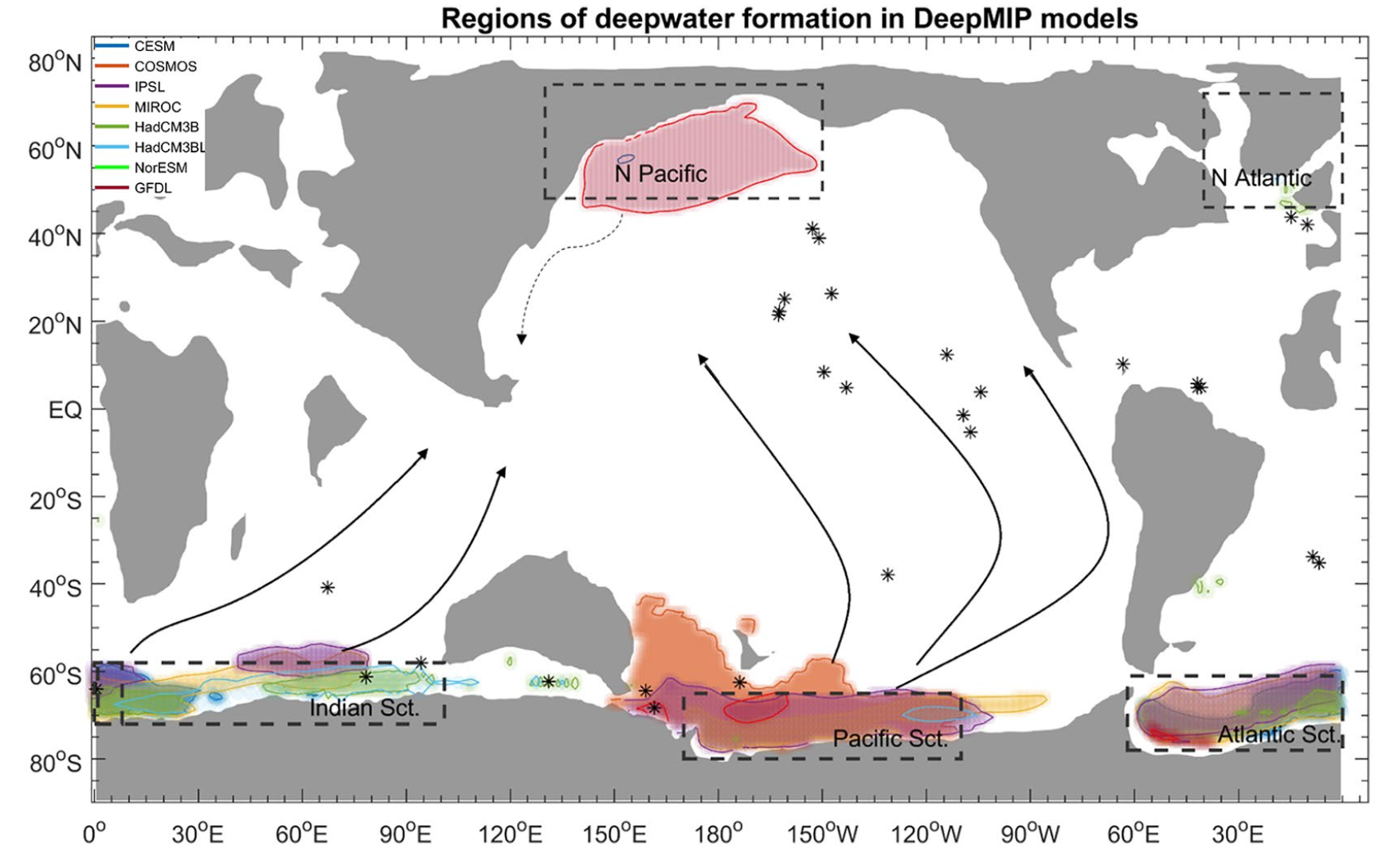 Early Eocene Ocean Meridional Overturning Circulation: The Roles of Atmospheric Forcing and Strait GeometryYurui Zhang, Agatha M. Boer, Daniel J. Lunt, David K. Hutchinson, Phoebe Ross, Tina Flierdt, Philip Sexton, Helen K. Coxall, Sebastian Steinig, Jean‐Baptiste Ladant, Jiang Zhu, Yannick Donnadieu, Zhongshi Zhang, Wing‐Le Chan, Ayako Abe‐Ouchi, Igor Niezgodzki, Gerrit Lohmann, Gregor Knorr, Christopher J. Poulsen, and Matt HuberPaleoceanography and Paleoclimatology, Mar 2022
Early Eocene Ocean Meridional Overturning Circulation: The Roles of Atmospheric Forcing and Strait GeometryYurui Zhang, Agatha M. Boer, Daniel J. Lunt, David K. Hutchinson, Phoebe Ross, Tina Flierdt, Philip Sexton, Helen K. Coxall, Sebastian Steinig, Jean‐Baptiste Ladant, Jiang Zhu, Yannick Donnadieu, Zhongshi Zhang, Wing‐Le Chan, Ayako Abe‐Ouchi, Igor Niezgodzki, Gerrit Lohmann, Gregor Knorr, Christopher J. Poulsen, and Matt HuberPaleoceanography and Paleoclimatology, Mar 2022Here, we compare the ocean overturning circulation of the early Eocene (47–56 Ma) in eight coupled climate model simulations from the Deep-Time Model Intercomparison Project (DeepMIP) and investigate the causes of the observed inter-model spread. The most common global meridional overturning circulation (MOC) feature of these simulations is the anticlockwise bottom cell, fed by sinking in the Southern Ocean. In the North Pacific, one model (GFDL) displays strong deepwater formation and one model (CESM) shows weak deepwater formation, while in the Atlantic two models show signs of weak intermediate water formation (MIROC and NorESM). The location of the Southern Ocean deepwater formation sites varies among models and relates to small differences in model geometry of the Southern Ocean gateways. Globally, convection occurs in the basins with smallest local freshwater gain from the atmosphere. The global MOC is insensitive to atmospheric CO2 concentrations from 1× (i.e., 280 ppm) to 3× (840 ppm) pre-industrial levels. Only two models have simulations with higher CO2 (i.e., CESM and GFDL) and these show divergent responses, with a collapsed and active MOC, respectively, possibly due to differences in spin-up conditions. Combining the multiple model results with available proxy data on abyssal ocean circulation highlights that strong Southern Hemisphere-driven overturning is the most likely feature of the early Eocene. In the North Atlantic, unlike the present day, neither model results nor proxy data suggest deepwater formation in the open ocean during the early Eocene, while the evidence for deepwater formation in the North Pacific remains inconclusive.
-
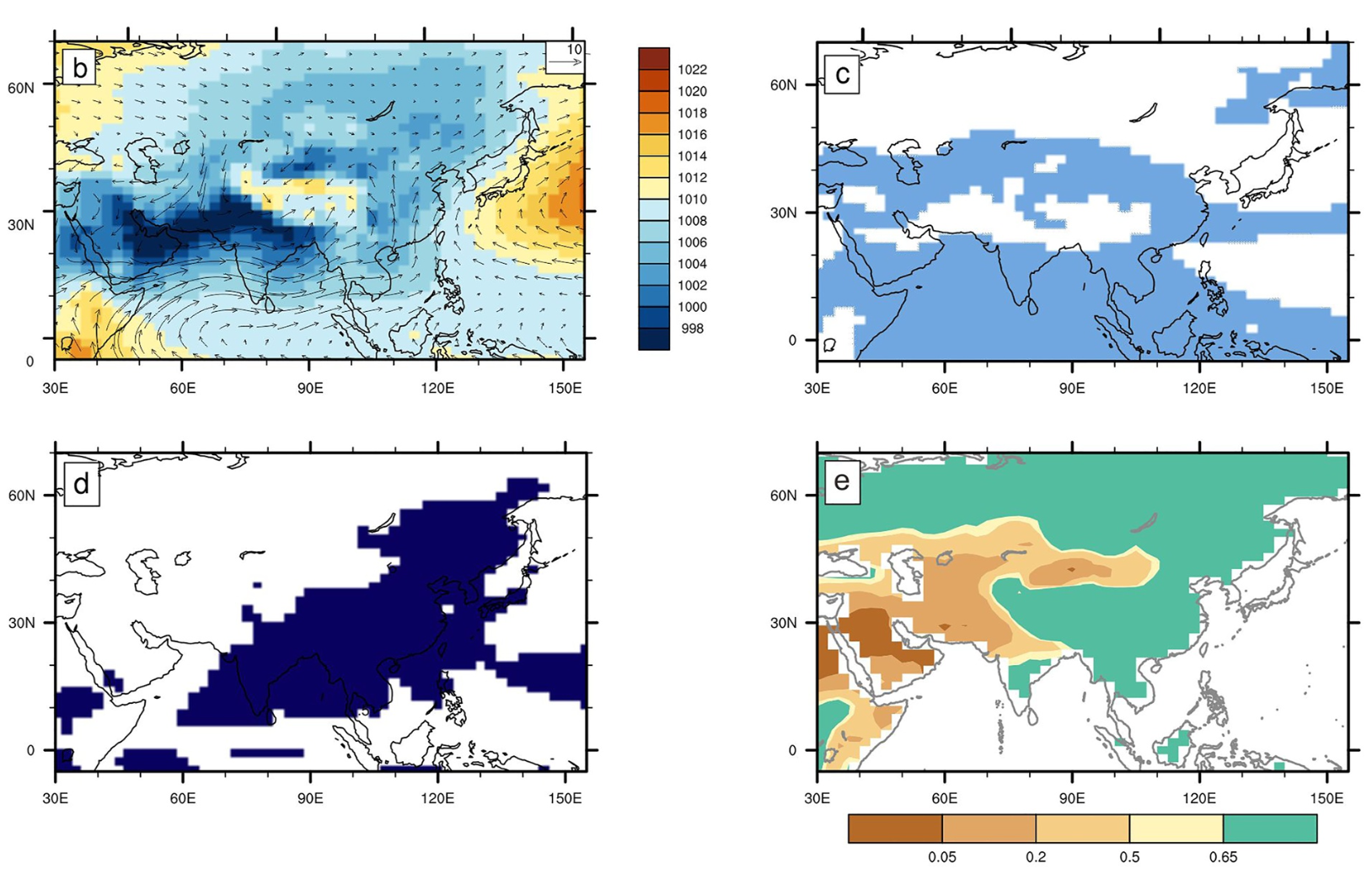 Impact of Mountains in Southern China on the Eocene Climates of East AsiaZijian Zhang, Zhongshi Zhang, Zhilin He, Ning Tan, Zhengtang Guo, Jiang Zhu, Sebastian Steinig, Yannick Donnadieu, Jean‐Baptiste Ladant, Wing‐Le Chan, Ayako Abe‐Ouchi, Igor Niezgodzki, Gregor Knorr, David K. Hutchinson, and Agatha M. De BoerJournal of Geophysical Research: Atmospheres, Sep 2022
Impact of Mountains in Southern China on the Eocene Climates of East AsiaZijian Zhang, Zhongshi Zhang, Zhilin He, Ning Tan, Zhengtang Guo, Jiang Zhu, Sebastian Steinig, Yannick Donnadieu, Jean‐Baptiste Ladant, Wing‐Le Chan, Ayako Abe‐Ouchi, Igor Niezgodzki, Gregor Knorr, David K. Hutchinson, and Agatha M. De BoerJournal of Geophysical Research: Atmospheres, Sep 2022Inconsistencies in the Eocene climates of East Asia have been revealed in both geological studies and simulations. Several earlier reconstructions showed an arid zonal band in mid-latitude China, but others showed a humid climate in the same region. Moreover, previous Eocene modeling studies have demonstrated that climate models can simulate both scenarios in China. Therefore, it is essential to investigate the cause of this model spread. We conducted a series of experiments using Norwegian Earth System Model 1-F and examined the impact of mountains in Southern China on the simulated Eocene climate. These mountains, including the Gangdese and Southeast Mountains, are located along the main path of water vapor transport to East Asia. Our results reveal that the Southeast Mountains play the dominant role in controlling the simulated precipitation in Eastern China during the Eocene. When the heights of the Southeast Mountains exceed ∼2,000 m, an arid zonal band appears in mid-latitude China, whereas humid climates appear in Eastern China when the elevation of the Southeast Mountains is relatively low.
2021
-
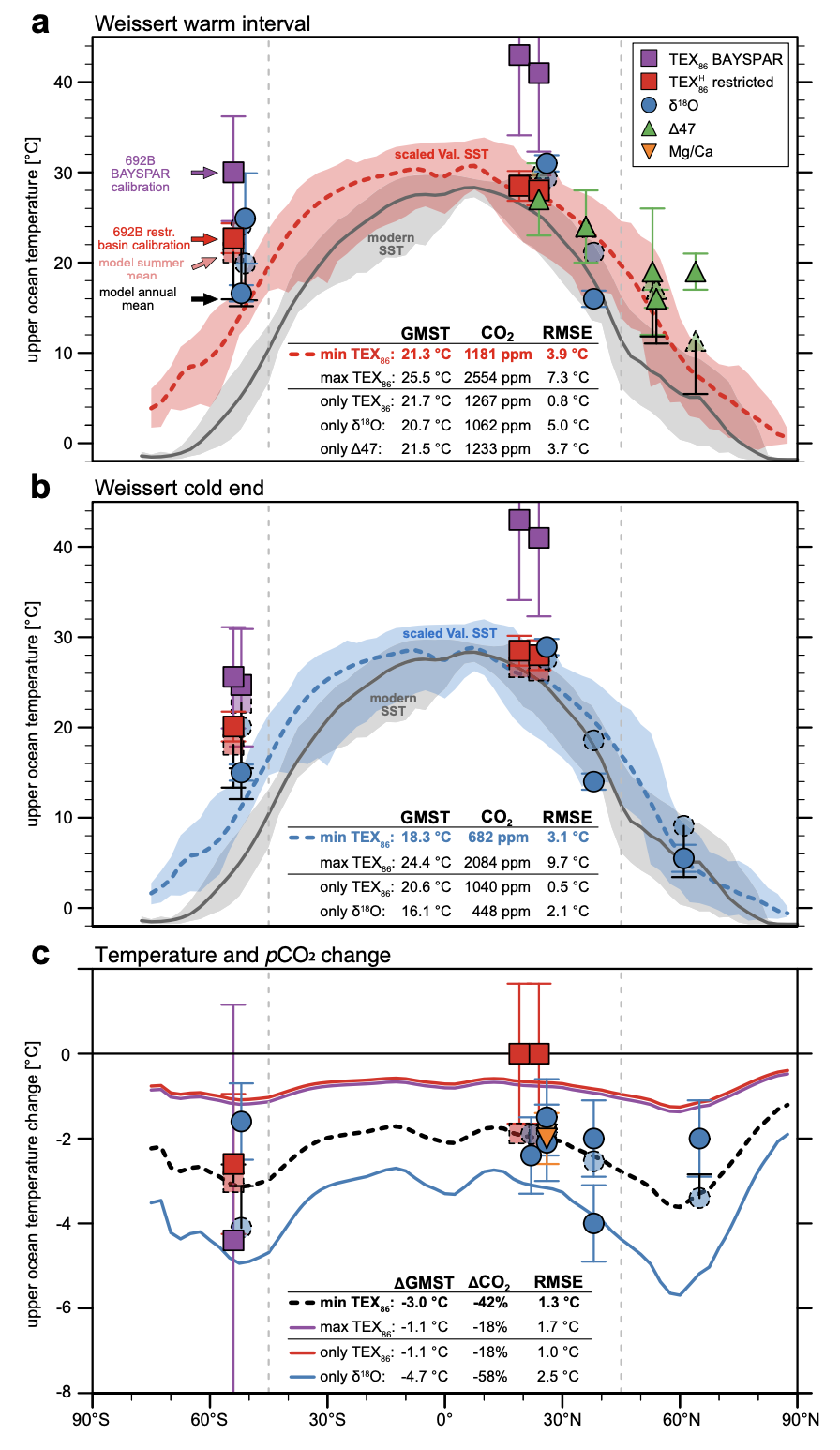 Impact of global cooling on Early Cretaceous high pCO2 world during the Weissert EventLiyenne Cavalheiro, Thomas Wagner, Sebastian Steinig, Cinzia Bottini, Wolf Dummann, Onoriode Esegbue, Gabriele Gambacorta, Victor Giraldo-Gómez, Alexander Farnsworth, Sascha Flögel, Peter Hofmann, Daniel J. Lunt, Janet Rethemeyer, Stefano Torricelli, and Elisabetta ErbaNature Communications, Sep 2021
Impact of global cooling on Early Cretaceous high pCO2 world during the Weissert EventLiyenne Cavalheiro, Thomas Wagner, Sebastian Steinig, Cinzia Bottini, Wolf Dummann, Onoriode Esegbue, Gabriele Gambacorta, Victor Giraldo-Gómez, Alexander Farnsworth, Sascha Flögel, Peter Hofmann, Daniel J. Lunt, Janet Rethemeyer, Stefano Torricelli, and Elisabetta ErbaNature Communications, Sep 2021Abstract The Weissert Event ~133 million years ago marked a profound global cooling that punctuated the Early Cretaceous greenhouse. We present modelling, high-resolution bulk organic carbon isotopes and chronostratigraphically calibrated sea surface temperature (SSTs) based on an organic paleothermometer (the TEX 86 proxy), which capture the Weissert Event in the semi-enclosed Weddell Sea basin, offshore Antarctica (paleolatitude ~54 °S; paleowater depth ~500 meters). We document a ~3–4 °C drop in SST coinciding with the Weissert cold end, and converge the Weddell Sea data, climate simulations and available worldwide multi-proxy based temperature data towards one unifying solution providing a best-fit between all lines of evidence. The outcome confirms a 3.0 °C ( ±1.7 °C) global mean surface cooling across the Weissert Event, which translates into a ~40% drop in atmospheric p CO 2 over a period of ~700 thousand years. Consistent with geologic evidence, this p CO 2 drop favoured the potential build-up of local polar ice.
-
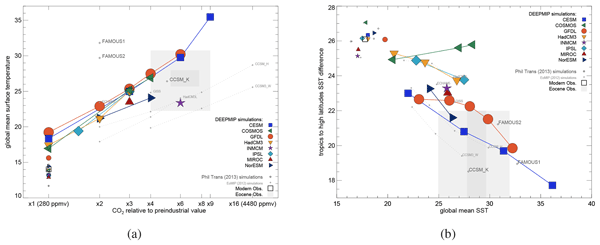 DeepMIP: model intercomparison of early Eocene climatic optimum (EECO) large-scale climate features and comparison with proxy dataDaniel J. Lunt, Fran Bragg, Wing-Le Chan, David K. Hutchinson, Jean-Baptiste Ladant, Polina Morozova, Igor Niezgodzki, Sebastian Steinig, Zhongshi Zhang, Jiang Zhu, Ayako Abe-Ouchi, Eleni Anagnostou, Agatha M. De Boer, Helen K. Coxall, Yannick Donnadieu, Gavin Foster, Gordon N. Inglis, Gregor Knorr, Petra M. Langebroek, Caroline H. Lear, Gerrit Lohmann, Christopher J. Poulsen, Pierre Sepulchre, Jessica E. Tierney, Paul J. Valdes, Evgeny M. Volodin, Tom Dunkley Jones, Christopher J. Hollis, Matthew Huber, and Bette L. Otto-BliesnerClimate of the Past, Jan 2021
DeepMIP: model intercomparison of early Eocene climatic optimum (EECO) large-scale climate features and comparison with proxy dataDaniel J. Lunt, Fran Bragg, Wing-Le Chan, David K. Hutchinson, Jean-Baptiste Ladant, Polina Morozova, Igor Niezgodzki, Sebastian Steinig, Zhongshi Zhang, Jiang Zhu, Ayako Abe-Ouchi, Eleni Anagnostou, Agatha M. De Boer, Helen K. Coxall, Yannick Donnadieu, Gavin Foster, Gordon N. Inglis, Gregor Knorr, Petra M. Langebroek, Caroline H. Lear, Gerrit Lohmann, Christopher J. Poulsen, Pierre Sepulchre, Jessica E. Tierney, Paul J. Valdes, Evgeny M. Volodin, Tom Dunkley Jones, Christopher J. Hollis, Matthew Huber, and Bette L. Otto-BliesnerClimate of the Past, Jan 2021We present results from an ensemble of eight climate models, each of which has carried out simulations of the early Eocene climate optimum (EECO, ∼ 50 million years ago). These simulations have been carried out in the framework of the Deep-Time Model Intercomparison Project (DeepMIP; http://www.deepmip.org, last access: 10 January 2021); thus, all models have been configured with the same paleogeographic and vegetation boundary conditions. The results indicate that these non-CO2 boundary conditions contribute between 3 and 5 ◦C to Eocene warmth. Compared with results from previous studies, the DeepMIP simulations generally show a reduced spread of the global mean surface temperature response across the ensemble for a given atmospheric CO2 concentration as well as an increased climate sensitivity on average. An energy balance analysis of the model ensemble indicates that global mean warming in the Eocene compared with the preindustrial period mostly arises from decreases in emissivity due to the elevated CO2 concentration (and associated water vapour and long-wave cloud feedbacks), whereas the reduction in the Eocene in terms of the meridional temperature gradient is primarily due to emissivity and albedo changes owing to the non-CO2 boundary conditions (i.e. the removal of the Antarctic ice sheet and changes in vegetation). Three of the models (the Community Earth System Model, CESM; the Geophysical Fluid Dynamics Laboratory, GFDL, model; and the Norwegian Earth System Model, NorESM) show results that are consistent with the proxies in terms of the global mean temperature, meridional SST gradient, and CO2, without prescribing changes to model parameters. In addition, many of the models agree well with the first-order spatial patterns in the SST proxies. However, at a more regional scale, the models lack skill. In particular, the modelled anomalies are substantially lower than those indicated by the proxies in the southwest Pacific; here, modelled continental surface air temperature anomalies are more consistent with surface air temperature proxies, implying a possible inconsistency between marine and terrestrial temperatures in either the proxies or models in this region. Our aim is that the documentation of the large-scale features and model–data comparison presented herein will pave the way to further studies that explore aspects of the model simulations in more detail, for example the ocean circulation, hydrological cycle, and modes of variability, and encourage sensitivity studies to aspects such as paleogeography, orbital configuration, and aerosols.
-
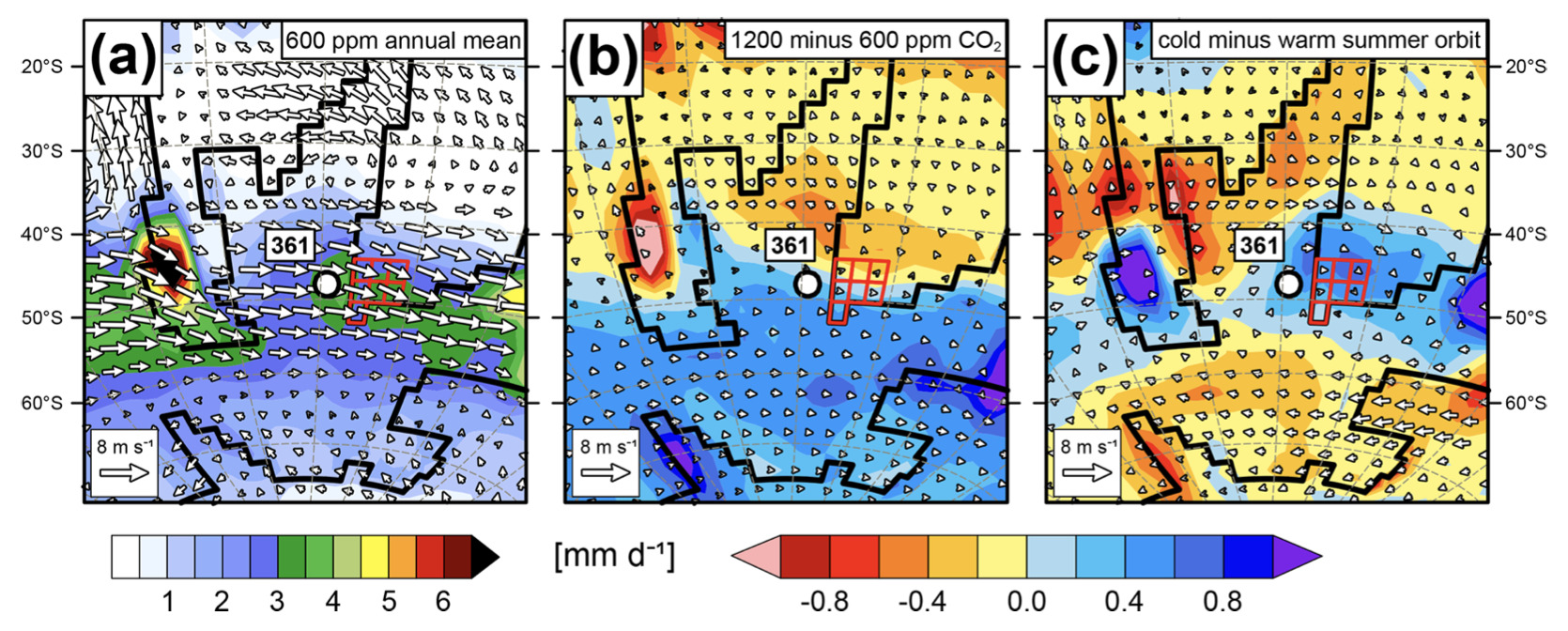 Driving mechanisms of organic carbon burial in the Early Cretaceous South Atlantic Cape Basin (DSDP Site 361)Wolf Dummann, Sebastian Steinig, Peter Hofmann, Matthias Lenz, Stephanie Kusch, Sascha Flögel, Jens Olaf Herrle, Christian Hallmann, Janet Rethemeyer, Haino Uwe Kasper, and Thomas WagnerClimate of the Past, Feb 2021
Driving mechanisms of organic carbon burial in the Early Cretaceous South Atlantic Cape Basin (DSDP Site 361)Wolf Dummann, Sebastian Steinig, Peter Hofmann, Matthias Lenz, Stephanie Kusch, Sascha Flögel, Jens Olaf Herrle, Christian Hallmann, Janet Rethemeyer, Haino Uwe Kasper, and Thomas WagnerClimate of the Past, Feb 2021Abstract. Extensive black shale deposits formed in the Early Cretaceous South Atlantic, supporting the notion that this emerging ocean basin was a globally important site of organic carbon burial. The magnitude of organic carbon burial in marine basins is known to be controlled by various tectonic, oceanographic, hydrological, and climatic processes acting on different temporal and spatial scales, the nature and relative importance of which are poorly understood for the young South Atlantic. Here we present new bulk and molecular geochemical data from an Aptian–Albian sediment record recovered from the deep Cape Basin at Deep Sea Drilling Project (DSDP) Site 361, which we combine with general circulation model results to identify driving mechanisms of organic carbon burial. A multimillion-year decrease (i.e., Early Aptian–Albian) in organic carbon burial, reflected in a lithological succession of black shale, gray shale, and red beds, was caused by increasing bottom water oxygenation due to abating hydrographic restriction via South Atlantic–Southern Ocean gateways. These results emphasize basin evolution and ocean gateway development as a decisive primary control on enhanced organic carbon preservation in the Cape Basin at geological timescales (\textgreater 1 Myr). The Early Aptian black shale sequence comprises alternations of shales with high (\textgreater 6 %) and relatively low (∼ 3.5 %) organic carbon content of marine sources, the former being deposited during the global Oceanic Anoxic Event (OAE) 1a, as well as during repetitive intervals before and after OAE 1a. In all cases, these short-term intervals of enhanced organic carbon burial coincided with strong influxes of sediments derived from the proximal African continent, indicating closely coupled climate–land–ocean interactions. Supported by our model results, we show that fluctuations in weathering-derived nutrient input from the southern African continent, linked to changes in orbitally driven humidity and aridity, were the underlying drivers of repetitive episodes of enhanced organic carbon burial in the deep Cape Basin. These results suggest that deep marine environments of emerging ocean basins responded sensitively and directly to short-term fluctuations in riverine nutrient fluxes. We explain this relationship using the lack of wide and mature continental shelf seas that could have acted as a barrier or filter for nutrient transfer from the continent into the deep ocean.
2020
-
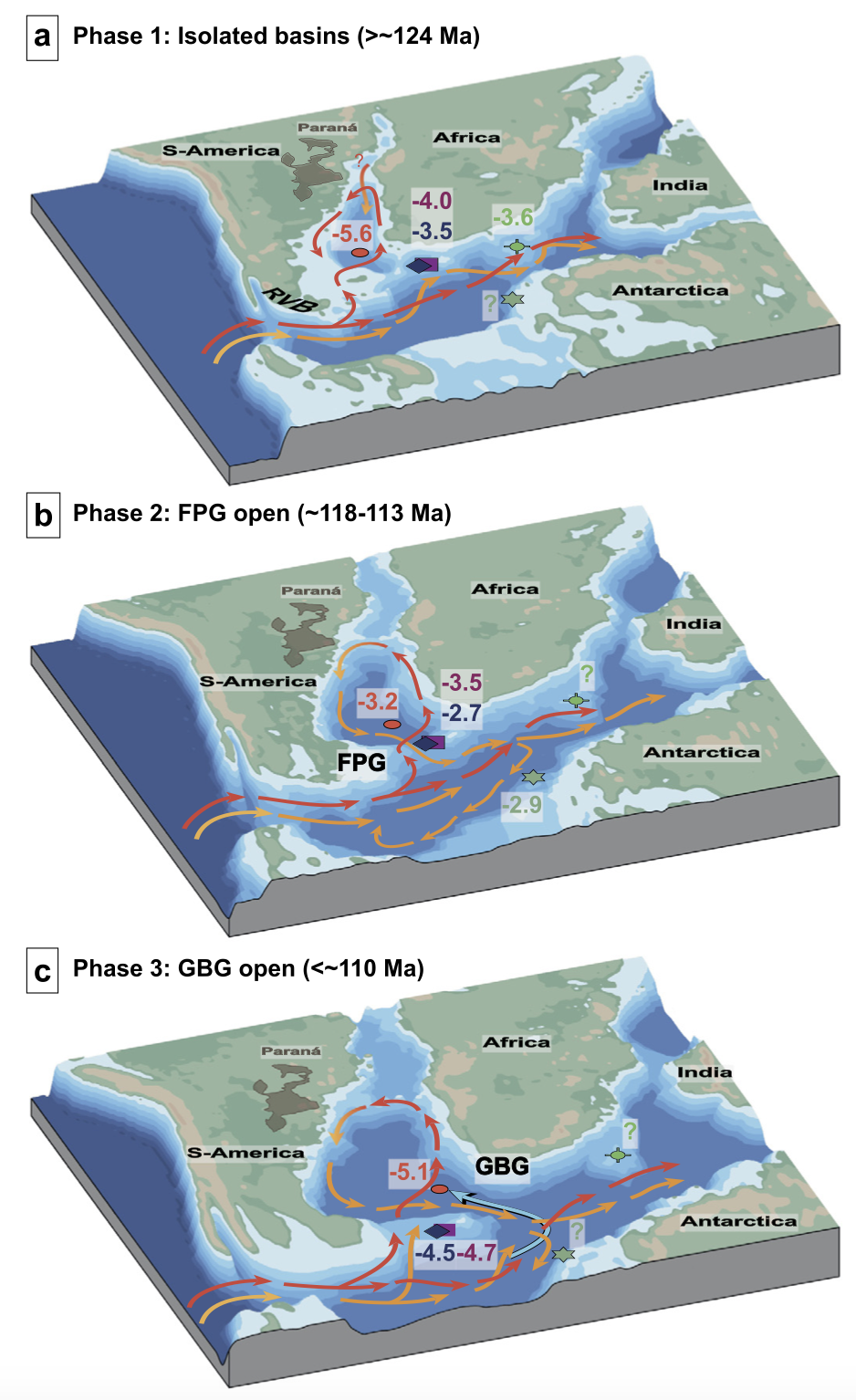 The impact of Early Cretaceous gateway evolution on ocean circulation and organic carbon burial in the emerging South Atlantic and Southern Ocean basinsW. Dummann, S. Steinig, P. Hofmann, S. Flögel, A.H. Osborne, M. Frank, J.O. Herrle, L. Bretschneider, R.M. Sheward, and T. WagnerEarth and Planetary Science Letters, Jan 2020
The impact of Early Cretaceous gateway evolution on ocean circulation and organic carbon burial in the emerging South Atlantic and Southern Ocean basinsW. Dummann, S. Steinig, P. Hofmann, S. Flögel, A.H. Osborne, M. Frank, J.O. Herrle, L. Bretschneider, R.M. Sheward, and T. WagnerEarth and Planetary Science Letters, Jan 2020Organic carbon burial is an important driver of carbon cycle and climate dynamics on geological and shorter time scales. Ocean basins emerging during the Early Cretaceous break-up of Gondwana were primary sites of organic carbon burial, implying that their tectonic and oceanographic evolution may have affected trends and perturbations in global climate via changes in local organic carbon burial. Assessing the role of individual ocean basins in the global carbon-climate context requires a sound understanding of the processes that induced large-scale changes in carbon burial and the timing of these changes. Here we reconstruct the oceanographic evolution, and its links to organic carbon burial, in the Barremian to Albian South Atlantic and Southern Ocean basins, which may have acted as carbon sinks of global importance. Our reconstruction is based on combined seawater neodymium isotope and sedimentological records obtained from multiple deep sea drill sites and a new general circulation model. Deep water circulation within and between those basins was primarily controlled by the opening of the shallow Falkland Plateau Gateway (between ∼118 Ma and ∼113 Ma) and the deep Georgia Basin Gateway (by ∼110 Ma), for which we provide new age constraints based on biostratigraphic and carbon isotope data. The opening of these gateways was accompanied by local to basin-wide decreases in organic carbon burial, suggesting that ocean circulation affected the oxygenation state via changes in deep water ventilation. Although our data do not provide quantitative information on the impact of changes in regional organic carbon burial on the global carbon cycle, the synchronicity between the reduction of organic carbon burial in the South Atlantic basin and global warming during the Early Albian points to a strong causal relationship.
-
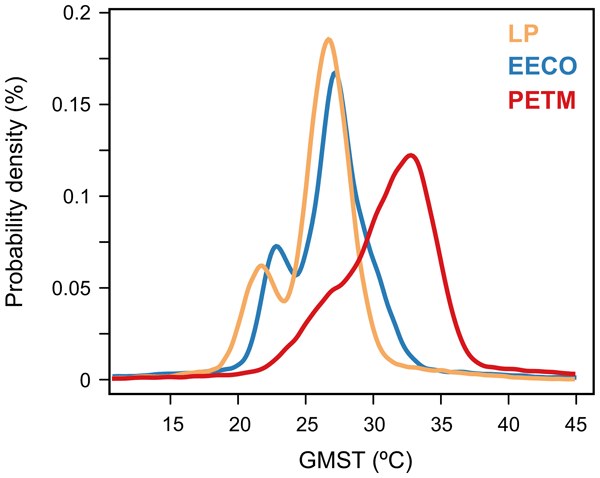 Global mean surface temperature and climate sensitivity of the early Eocene Climatic Optimum (EECO), Paleocene–Eocene Thermal Maximum (PETM), and latest PaleoceneGordon N. Inglis, Fran Bragg, Natalie J. Burls, Margot J. Cramwinckel, David Evans, Gavin L. Foster, Matthew Huber, Daniel J. Lunt, Nicholas Siler, Sebastian Steinig, Jessica E. Tierney, Richard Wilkinson, Eleni Anagnostou, Agatha M. De Boer, Tom Dunkley Jones, Kirsty M. Edgar, Christopher J. Hollis, David K. Hutchinson, and Richard D. PancostClimate of the Past, Oct 2020
Global mean surface temperature and climate sensitivity of the early Eocene Climatic Optimum (EECO), Paleocene–Eocene Thermal Maximum (PETM), and latest PaleoceneGordon N. Inglis, Fran Bragg, Natalie J. Burls, Margot J. Cramwinckel, David Evans, Gavin L. Foster, Matthew Huber, Daniel J. Lunt, Nicholas Siler, Sebastian Steinig, Jessica E. Tierney, Richard Wilkinson, Eleni Anagnostou, Agatha M. De Boer, Tom Dunkley Jones, Kirsty M. Edgar, Christopher J. Hollis, David K. Hutchinson, and Richard D. PancostClimate of the Past, Oct 2020Abstract. Accurate estimates of past global mean surface temperature (GMST) help to contextualise future climate change and are required to estimate the sensitivity of the climate system to CO2 forcing through Earth’s history. Previous GMST estimates for the latest Paleocene and early Eocene (∼57 to 48 million years ago) span a wide range (∼9 to 23 ∘C higher than pre-industrial) and prevent an accurate assessment of climate sensitivity during this extreme greenhouse climate interval. Using the most recent data compilations, we employ a multi-method experimental framework to calculate GMST during the three DeepMIP target intervals: (1) the latest Paleocene (∼57 Ma), (2) the Paleocene–Eocene Thermal Maximum (PETM; 56 Ma), and (3) the early Eocene Climatic Optimum (EECO; 53.3 to 49.1 Ma). Using six different methodologies, we find that the average GMST estimate (66 per cent confidence) during the latest Paleocene, PETM, and EECO was 26.3 ∘C (22.3 to 28.3 ∘C), 31.6 ∘C (27.2 to 34.5 ∘C), and 27.0 ∘C (23.2 to 29.7 ∘C), respectively. GMST estimates from the EECO are ∼10 to 16 ∘C warmer than pre-industrial, higher than the estimate given by the Intergovernmental Panel on Climate Change (IPCC) 5th Assessment Report (9 to 14 ∘C higher than pre-industrial). Leveraging the large “signal” associated with these extreme warm climates, we combine estimates of GMST and CO2 from the latest Paleocene, PETM, and EECO to calculate gross estimates of the average climate sensitivity between the early Paleogene and today. We demonstrate that “bulk” equilibrium climate sensitivity (ECS; 66 per cent confidence) during the latest Paleocene, PETM, and EECO is 4.5 ∘C (2.4 to 6.8 ∘C), 3.6 ∘C (2.3 to 4.7 ∘C), and 3.1 ∘C (1.8 to 4.4 ∘C) per doubling of CO2. These values are generally similar to those assessed by the IPCC (1.5 to 4.5 ∘C per doubling CO2) but appear incompatible with low ECS values (\textless1.5 per doubling CO2).
-
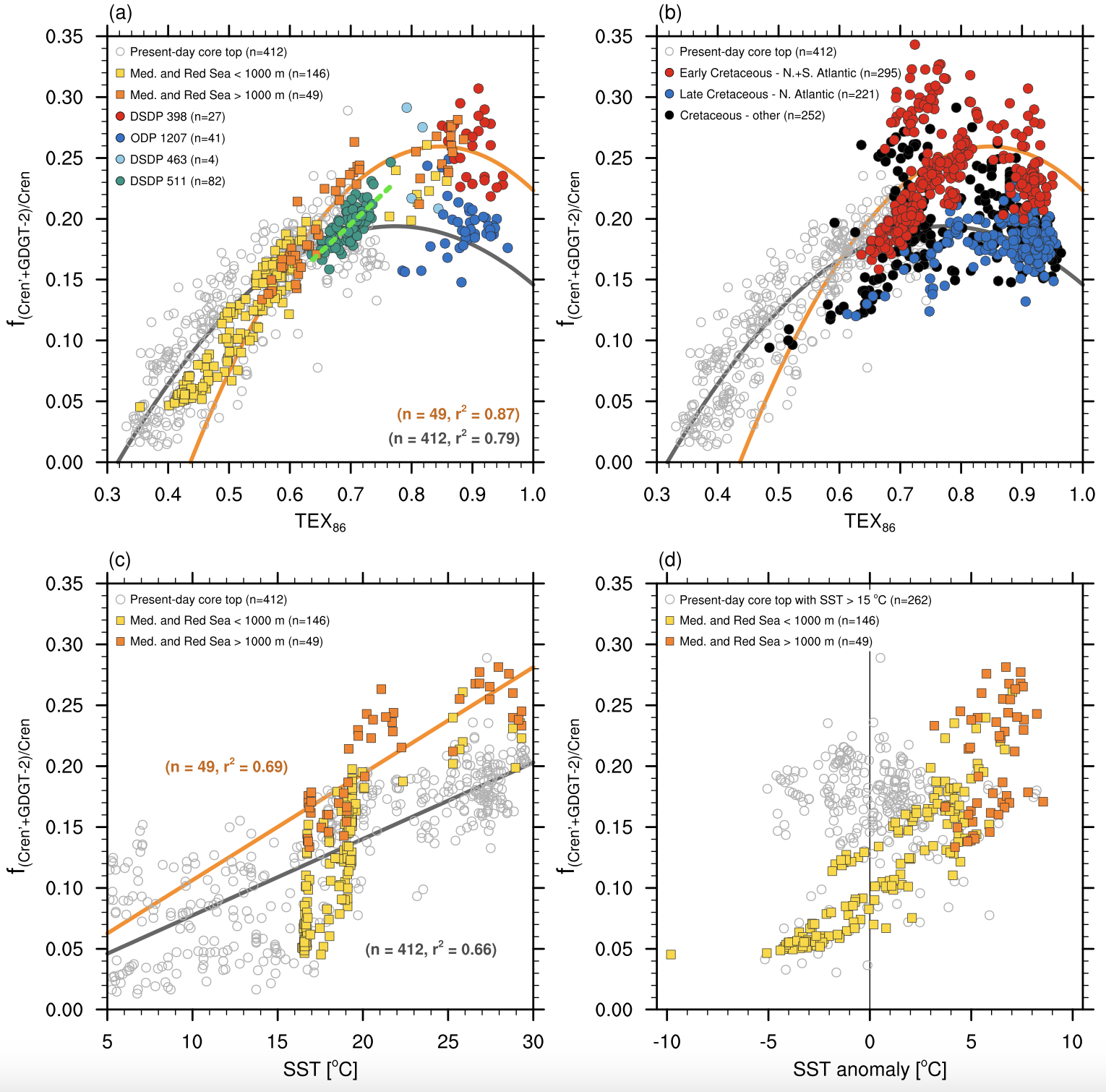 Evidence for a regional warm bias in the Early Cretaceous TEX86 recordSebastian Steinig, Wolf Dummann, Wonsun Park, Mojib Latif, Stephanie Kusch, Peter Hofmann, and Sascha FlögelEarth and Planetary Science Letters, Jun 2020
Evidence for a regional warm bias in the Early Cretaceous TEX86 recordSebastian Steinig, Wolf Dummann, Wonsun Park, Mojib Latif, Stephanie Kusch, Peter Hofmann, and Sascha FlögelEarth and Planetary Science Letters, Jun 2020The Cretaceous Period (145-66 Ma) provides an opportunity to obtain insights into the adaptation of the climate system to increased atmospheric greenhouse gas concentrations. The organic paleothermometer TEX86 is one of the few proxies available for reconstructing quantitative estimates of upper ocean temperatures of this time period. Here we show that the sedimentary TEX86 signal in the Early Cretaceous North and South Atlantic shows systematic differences to other Cretaceous samples. In particular, the relative increase in the fractional abundances of the crenarchaeol isomer compared to crenarchaeol exhibits similarities with surface sediments from the modern Mediterranean and Red Sea. Dedicated climate model simulations suggest that the formation of warm and saline deep waters in the restricted North and South Atlantic may have influenced TEX86 export dynamics leading to a warm bias in reconstructed upper ocean temperatures. Applying a regional calibration from the modern Mediterranean and Red Sea to corresponding TEX86 data significantly improves the model-data fit for the Aptian Oceanic Anoxic Event 1a and the overall comparison with other temperature proxies for the Early Cretaceous. Our results demonstrate the need to consider regional and temporal changes of the TEX86-temperature relation for the reconstruction of deep-time ocean temperatures.
2019
-
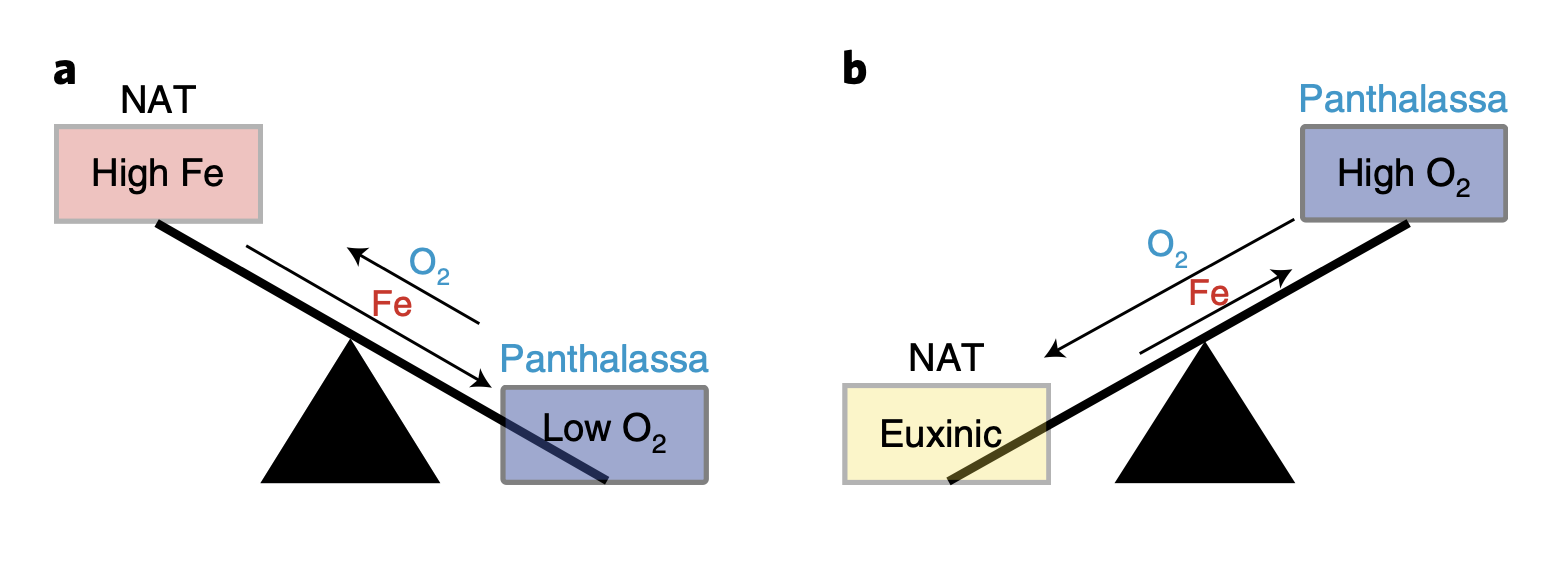 Periodic changes in the Cretaceous ocean and climate caused by marine redox see-sawKlaus Wallmann, Sascha Flögel, Florian Scholz, Andrew W. Dale, Tronje P. Kemena, Sebastian Steinig, and Wolfgang KuhntNature Geoscience, Jun 2019
Periodic changes in the Cretaceous ocean and climate caused by marine redox see-sawKlaus Wallmann, Sascha Flögel, Florian Scholz, Andrew W. Dale, Tronje P. Kemena, Sebastian Steinig, and Wolfgang KuhntNature Geoscience, Jun 2019Periodic changes in sediment composition are usually ascribed to insolation forcing controlled by Earth’s orbital parameters. During the Cretaceous Thermal Maximum at 97–91 Myr ago (Ma), a 37–50-kyr-long cycle that is generally believed to reflect obliquity forcing dominates the sediment record. Here, we use a numerical ocean model to show that a cycle of this length can be generated by marine biogeochemical processes without applying orbital forcing. According to our model, the restricted proto-North Atlantic and Tethys basins were poorly ventilated and oscillated between iron-rich and sulfidic (euxinic) states. The Panthalassa Basin was fertilized by dissolved iron originating from the proto-North Atlantic. Hence, it was less oxygen- ated while the proto-North Atlantic was in an iron-rich state and better oxygenated during euxinic periods in the proto-North Atlantic. This redox see-saw was strong enough to create significant changes in atmospheric pCO2. We conclude that most of the variability in the mid-Cretaceous ocean–atmosphere system can be ascribed to the internal redox see-saw and its response to external orbital forcing.
-
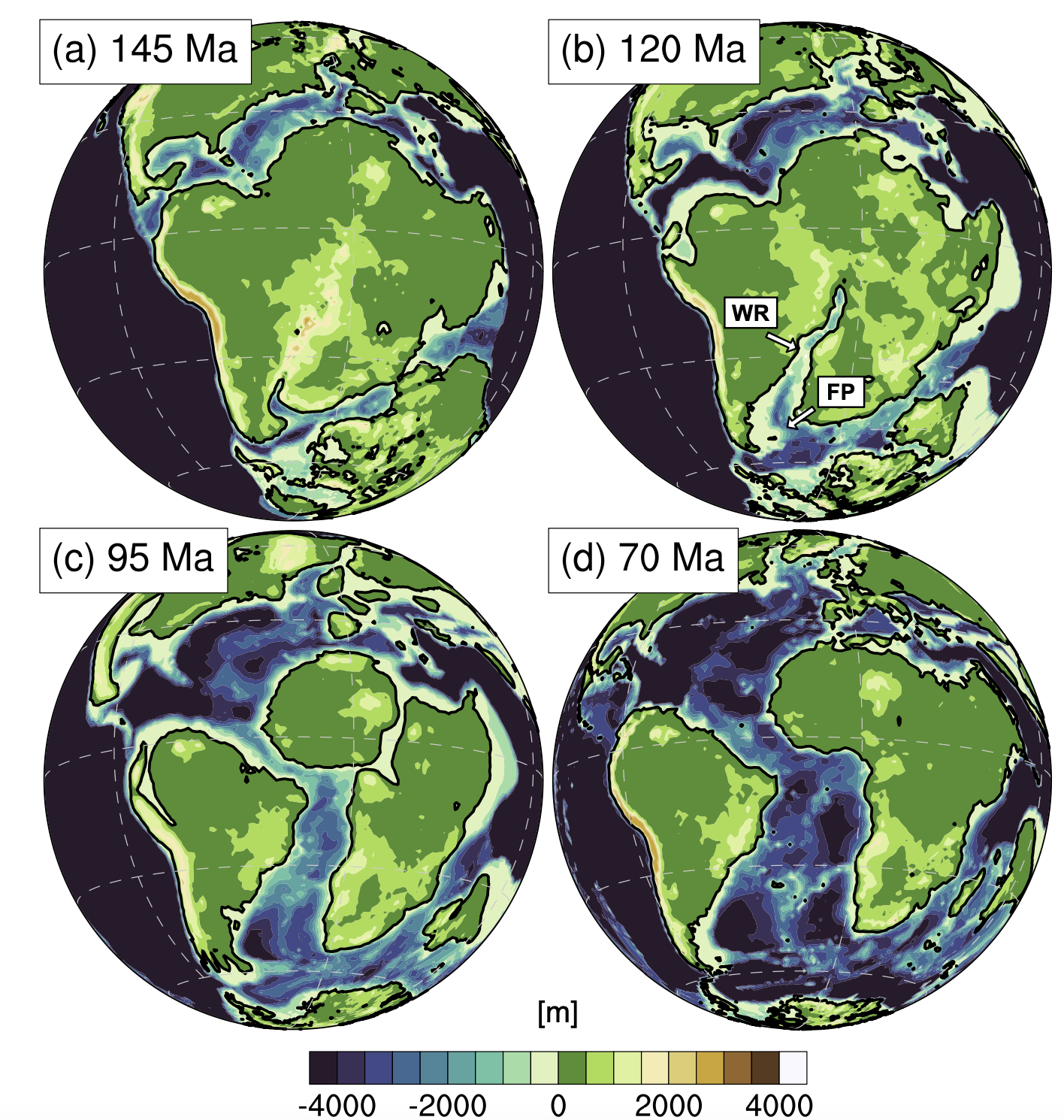 Evolving ocean basins in the Early Cretaceous greenhouse: A climate model-proxy synthesis of circulation, surface temperatures and carbon burialSebastian SteinigUniversity of Kiel, Jun 2019
Evolving ocean basins in the Early Cretaceous greenhouse: A climate model-proxy synthesis of circulation, surface temperatures and carbon burialSebastian SteinigUniversity of Kiel, Jun 2019Greenhouse climates with global mean temperatures significantly higher than today prevailed during large parts of the geological history. They provide direct evidence for the adaptation of the climate system to enhanced greenhouse gas forcing during the past and represent the only possibility to constrain model-derived projections of future anthropogenic warming. The Early Cretaceous ( 145-100.5 Ma) provides a special opportunity to test our understanding of past greenhouse dynamics, as the long-term warmth was punctuated by severe perturbations of the global carbon cycle and episodes of transient cooling. Young and restricted ocean basins, emerging from the break-up of Gondwana, are a possible driver of both short- and long-term carbon cycle dynamics due to their enhanced organic carbon burial potential. This thesis aims to better constrain the main drivers of the Early Cretaceous greenhouse climate and to assess how they differed from the present-day dynamics. Dedicated climate model simulations of the Early Cretaceous were integrated with paleoceanographic records of water mass mixing, surface temperatures and organic carbon burial to assess both the causes for the mean state warming, as well as to reconstruct the tectonically driven ocean circulation and carbon cycle changes.
2018
-
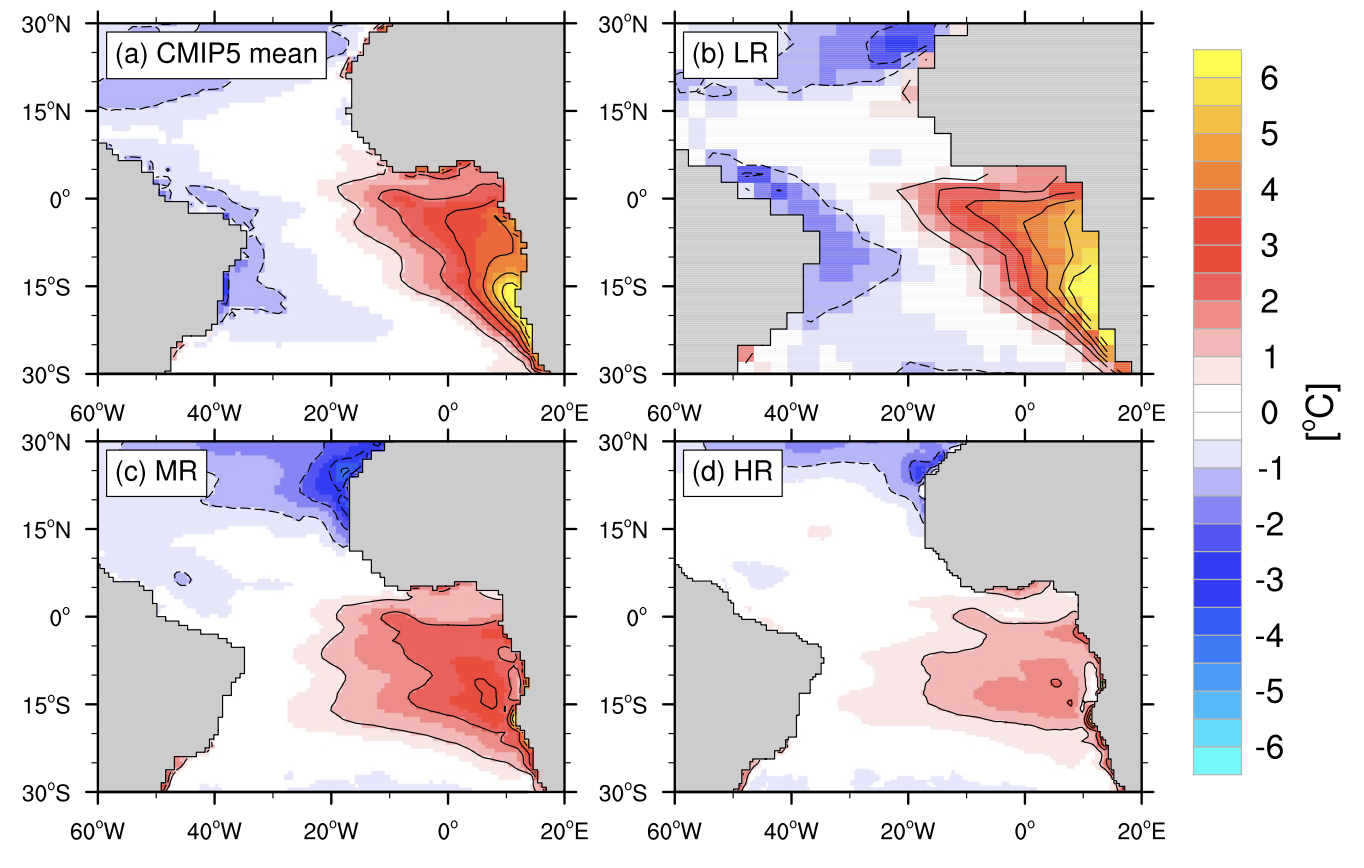 Sahel rainfall strength and onset improvements due to more realistic Atlantic cold tongue development in a climate modelS. Steinig, J. Harlaß, W. Park, and M. LatifScientific Reports, Feb 2018
Sahel rainfall strength and onset improvements due to more realistic Atlantic cold tongue development in a climate modelS. Steinig, J. Harlaß, W. Park, and M. LatifScientific Reports, Feb 2018Abstract The simulation of Sahel rainfall and its onset during the West African Monsoon (WAM) remains a challenge for current state-of-the-art climate models due to their persistent biases, especially in the tropical Atlantic region. Here we show that improved representation of Atlantic Cold Tongue (ACT) development is essential for a more realistic seasonal evolution of the WAM, which is due to a further inland migration of the precipitation maximum. The observed marked relationship between ACT development and Sahel rainfall onset only can be reproduced by a climate model, the Kiel Climate Model (KCM), when sufficiently high resolution in its atmospheric component is employed, enabling enhanced equatorial Atlantic interannual sea surface temperature variability in the ACT region relative to versions with coarser atmospheric resolution. The ACT/Sahel rainfall relationship in the model critically depends on the correct seasonal phase-locking of the interannual variability rather than on its magnitude. We compare the KCM results with those obtained from climate models participating in the Coupled Model Intercomparison Project phase 5 (CMIP5).